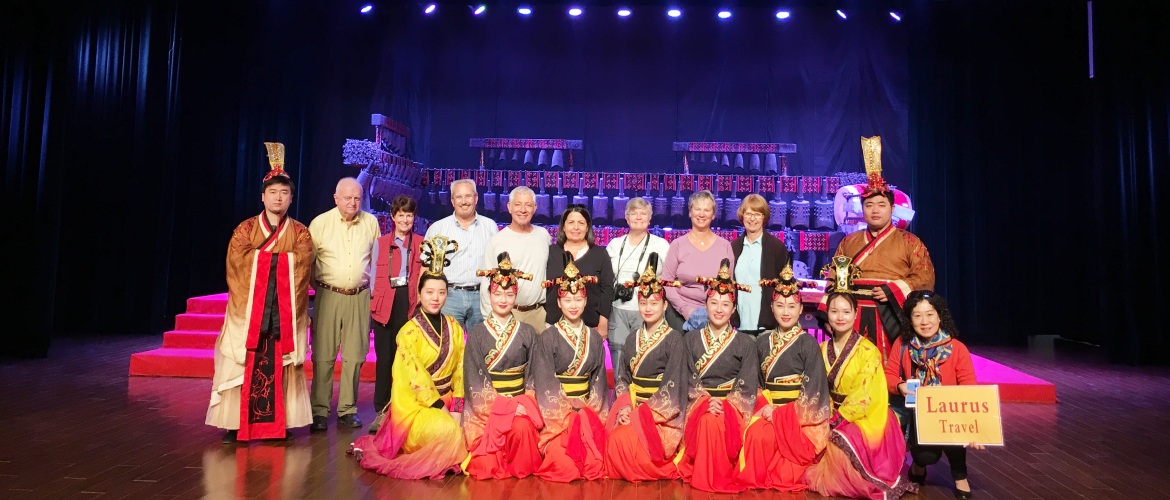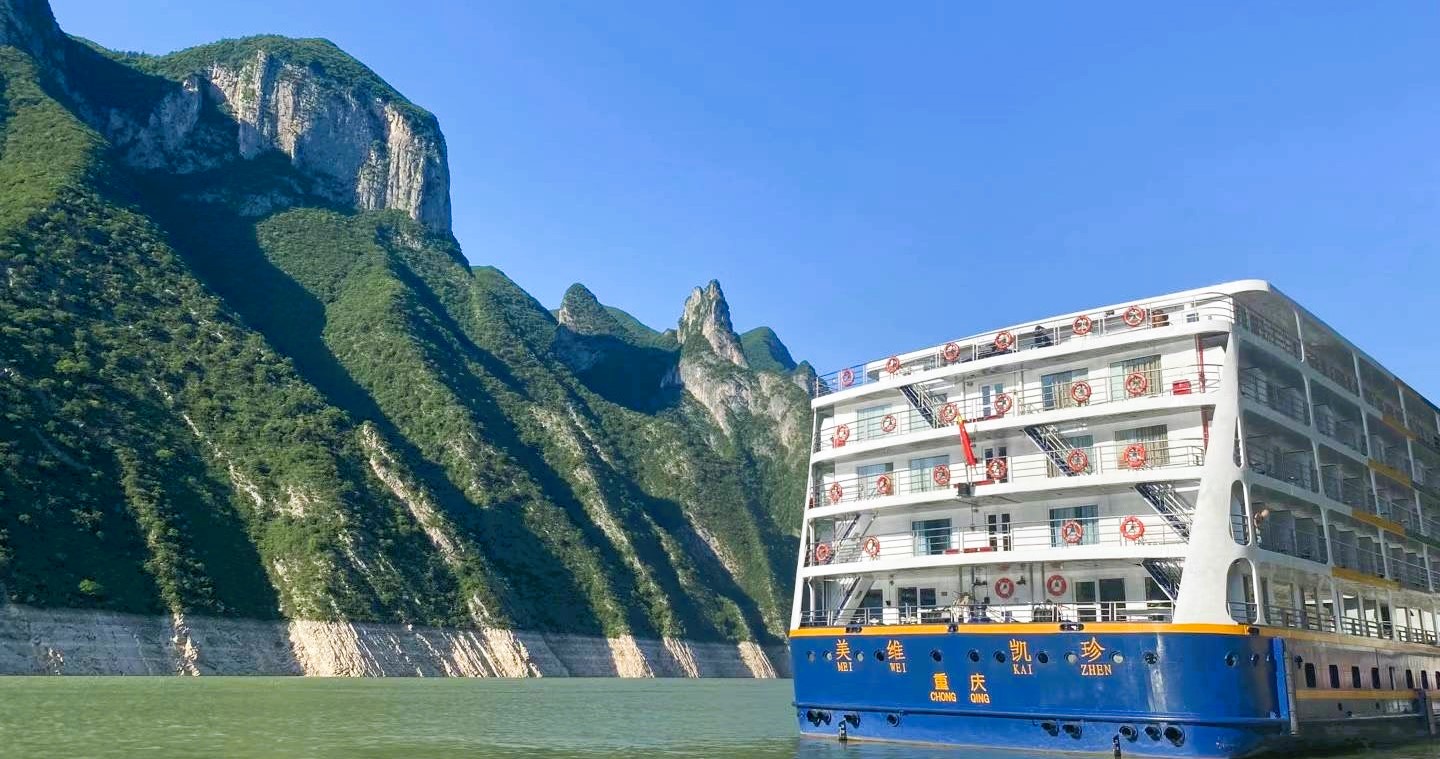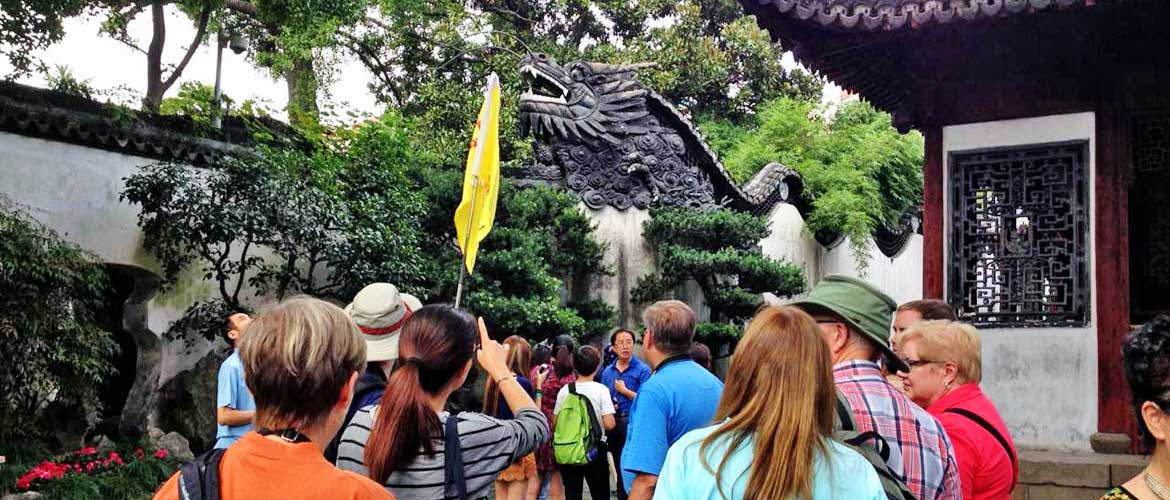
Beijing – Xi’an – Chengdu – Chongqing – Yangtze Cruise – Yichang – Wuhan – Shanghai
This popular small group China tour features China’s top three tourist cities plus a first-class cruise through the mighty Three Gorges on the Yangtze River. Trip highlights include the Great Wall at Mutianyu, Forbidden City, Temple of Heaven, Summer Palace and the Terracotta Army.
Important Features
- Small group size – average 15, maximum 20.
- Inter-city travel exclusively by high-speed train.
- No annoying forced shopping of any kind.
- Quality meals at non-tourist restaurants.
- Unlimited supply of bottled water during group activities.
- Outside cabin on or above bridge deck for Yangtze cruise.
- Free Wi-Fi in all hotels.
- Great Wall visit at Mutianyu with cable car rides.
Options Available
- Peking Opera show with dinner in Beijing.
- Tang Dynasty cultural show with dinner in Xi’an.
- Traditional face mask changing performance with dinner in Chengdu.
- Half-day immersive tea farm visit in Guilin.
- 2-day post-tour Yellow Mountain extension.

ITINERARY
Meal Code: B = breakfast / L = lunch / D = dinner
Day 1/Thu: Departing for Beijing
The trip starts with your transpacific flight departing from a city of your choice. You’ll lose a day upon crossing the International Date Line.
Day 2/Fri: Arrival in Beijing
Meet the driver on arrival for transfer to the hotel. You’ll have the remainder of the day at leisure. The guide will get in touch with you tonight.
Day 3/Sat: Beijing (B/L/D)
The capital of China, Beijing is a world-class cultural and educational centre. It has a population around 21.9 million (2020) and ranks behind Shanghai as China’s second largest city. Beijing is renowned for its opulent palaces, temples, and huge stone walls and gates – treasures that make it the most popular tourist city in China by the number of visitors it receives every year.
We begin today with a visit to the Forbidden City. Officially known as the Palace Museum, the Forbidden City was the place where the emperors of the Ming (1368-1644) and Qing (1644-1912) dynasties lived and carried out their administration. Construction of the Forbidden City took 14 years (1406-1420) to complete. The complex consists of 980 buildings and covers 72 hectares or 180 acres. It exemplifies traditional Chinese palatial architecture and has influenced cultural and architectural developments in East Asia and elsewhere. Though the Qing Dynasty was overthrown in 1912, the royal family was allowed to continue to live in the Forbidden City till 1924, when the last emperor, Pu Yi, was driven out of the imperial palace. One year later the Forbidden City was turned into a museum. Declared a World Heritage Site by UNESCO in 1987, this is the largest collection of preserved ancient wooden structures in the world.
Next up is Tian’anmen Square. Located in the heart of Beijing, the square measures 880 metres from north to south and 500 meters from east to west. Said to be the largest public plaza in the world, Tian’anmen Square has the capacity to hold one million people. The imposing Tian’anmen Tower sits at the north end of the square while the Monument to the People’s Heroes dominates the centre. The square is flanked by The Great Hall of the People (west) and the National Museum (east). Chairman Mao’s Mausoleum and Qianmen (Front Gate) are located in the south of the square. One of the top 16 tourist attractions in Beijing, Tian’anmen Square is also the witness of the Chinese people’s great struggles for democracy and personal freedom since 1919.
Afternoon sightseeing takes place at the Temple of Heaven, another UNESCO World Heritage Site. Situated in southeastern Beijing, the Temple of Heaven is China’s largest extant sacrificial temple where, during the Ming and Qing Dynasties, the emperors conducted the elaborate and most exalted sacrifices addressed to “the Supreme Ruler of the Universe”. Construction of the temple started in 1406, during the reign of the Ming Emperor Yongle, and took 14 years to complete. The temple was expanded under the Qing emperors Qianlong (1736-1796) and Jiaqing (1796-1820). Occupying 2.73 square kilometres (roughly 1,700 by 1,600 metres), the area of the Temple of Heaven is more than twice that of the Forbidden City.
The famous Hongqiao Pearl Market, the largest pearl market in the world, is right across the street from the Temple of Heaven. Recommended by numerous guidebooks for freshwater pearls, Hongqiao teems with domestic and international shoppers. If you are interested, please ask the guide to drop you off there. However, you’ll need to get back to the hotel by taxi, which costs about 8 US dollars.
Today we enjoy a delicious dinner at a popular Peking Roast Duck restaurant. Peking Roast Duck is a famous Beijing dish prized for the thin and crispy skin with authentic versions serving mostly the skin and little meat, sliced in front of the diners.
Day 4/Sun: Beijing (B/L)
After an early breakfast we embark on a full-day excursion to the legendary Great Wall at Mutianyu, 75 km northeast of the city.
Zigzagging over 6,000 kilometres from east to west along undulating mountains, the Great Wall was built to hold off tribal invaders from the north. As history shows, the Wall failed the Chinese rulers miserably, especially in the case of Kublai Khan whose cavalrymen swept across China from the Mongolian steppe, thus the beginning of the Yuan Dynasty (1279-1368).
Construction of the earliest sections of the Wall started in the 7th century BCE. A major renovation started with the founding of the Ming Dynasty in 1368 and took 200 years to complete. The wall we see today in Beijing is almost exactly the result of this effort.
Day 5/Mon: Beijing – Xi’an (B/L/D)
We begin our sightseeing today with a visit to a traditional hutong neighbourhood. Hutong refers to an ancient alleyway with siheyuan or ”4-sided courtyard house” on both sides. The name hutong dates back to the Yuan Dynasty (1279 – 1368 CE). According to some experts, the word originated from the Mongolian language, in which it is pronounced as “hottog” and means “well”. In ancient times, people tended to gather and live around wells. Therefore, the original meaning of hutong should be “a place where people live around.”
Next on our schedule is the Summer Palace, a well-preserved UNESCO World Cultural Heritage Site. The imperial resort was first named Garden of Clear Ripples, which was burnt down by the allied forces of Great Britain and France in 1860 at the end of the Second Opium War (often referred to as the Arrow War by the British). Reconstruction started 25 years later and was completed in 1895 when the name was changed to Yi He Yuan (Garden of Good Health and Harmony). The design gives prominence to Longevity Hill, as well as Kunming Lake south of the hill. The sprawling complex covers an area of 290 hectares and the buildings inside consist of over 3,000 bays.
We travel to Xi’an by high-speed train (#G87, 14:00/18:23). The 4-hour-23-minute rail journey through fertile farmland dotted with villages provides the visitor with an excellent way to enjoy the beautiful countryside. The track we travel on between Beijing and Zhengzhou is part of the new 2,298 km high-speed railway linking Beijing and subtropical Guangzhou and is also the longest high-speed rail line in the world. In the past 20 years China has been on a building spree expanding the country’s rail network and upgrading existing railways. Its high-speed rail service rivals France’s TGV and Japan’s “shinkansen” in terms of safety, speed, comfort and punctuality.
Day 6/Tue: Xi’an (B/L)
With a history going back over 3,000 years, Xi’an served as China’s capital of several ruling dynasties including the Han (206 BCE – 220 CE) and the Tang (618 – 907). It is home to the famous Terracotta Army and the eastern terminus of the ancient Silk Road – a network of trade routes connecting China proper with regions as far as the Mediterranean beginning in the Second Century BCE.
We spend the morning visiting the Terracotta Army. Built on the excavation site, the museum is located 30 km east of the city. Designed to follow the first emperor of the Qin Dynasty (221-206 BCE) into eternity, the Terracotta Army represents one of the greatest archeological discoveries of the 20th century.
After lunch we return to the city for a stroll on the ancient city wall. Declared a national treasure by the State Council in 1961, the wall (first built in 1370) encircles an area of 14 square kilometres. It runs 13.7 kilometres long and measures 12 metres in height with a base thickness between 15 to 18 metres.
Day 7/Wed: Xi’an – Chengdu (B/L/D)
Morning sightseeing begins at Shaanxi Provincial Museum. The modern, well-organized museum was completed in 1992 and traces the history of Xi’an from prehistory to the Qing dynasty (1644-1912). The extensive galleries and exhibitions offer the visitor an excellent introduction to the area that greatly improves understanding of the numerous historical sites in and around the city.
We then visit the grand mosque in the old town centre and the adjacent Muslim bazaar. The mosque was established in the 8th century and the majority of the complex was constructed in the Ming Dynasty (1368-1644). It was further expanded in the Qing Dynasty. Unlike mosques in Middle Eastern or Arab countries, this mosque is completely Chinese in style. It has neither domes nor traditional minarets.
This afternoon we ride the bullet train (G1975, 14:34/18:25) to Chengdu. Capital of populous Sichuan Province, Chengdu is an ancient city with a population of 14 million. The fertile Chengdu Plain, on which Chengdu is located, is often referred to by the Chinese “Country of Heaven”, a phrase also translated as “The Land of Abundance”. The discovery of the Jinsha archaeological site suggests the area had become the centre of the Bronze Age Sanxingdui Culture around the time of the establishment of the state of Shu prior to its annexation by Qin in 316 BCE.
Day 8/Thu: Chengdu (B/L)
Morning sightseeing takes place at Chengdu Research Base of Giant Panda Breeding. The giant panda, unrelated to the red or lesser panda, is a bear native to south central China, living in mountainous regions. It is easily recognized by the large, distinctive black patches around its eyes, over the ears, and across its round body. Though it belongs to the order Carnivora, the panda’s diet is over 99% bamboo. The giant panda has an insatiable appetite for bamboo. A typical animal eats half the day – a full 12 out of every 24 hours – and relieves itself dozens of times a day. Giant pandas are solitary creatures. They have a highly developed sense of smell that males use to avoid each other and to find females for mating in the spring. After a five-month pregnancy, females give birth to a cub or two, though they cannot care for both twins. The blind infants, born fully white, weigh only 5 ounces (142 grams) at birth and cannot crawl until they reach three months of age.
The giant panda is a conservation-reliant species. Although no longer considered by the International Union for Conservation of Nature (IUCN) to be Endangered, the species is still classified as Vulnerable. Recent statistics (late 2022) shows 637 pandas living in captivity with most of them inside China. The most authoritative estimate as of late 2022 puts the number of giant pandas living in the wilderness at 1864.
We spend most of the afternoon at Jinsha Museum. In February 2001, construction workers chanced upon a significant archaeological discovery in modern China. The discovery led to the naming of Jinsha culture (1200 – 650 BCE) and a museum was erected at the excavation site. Jinsha culture flourished around 1000 BCE and shares similarities in burial objects with the Sanxingdui site located 50 km from Chengdu. Objects made of ivory, jade, bronze, gold and stone were unearthed at the site. Unlike the site at Sanxingdui, Jinsha did not have a city wall. Jinsha culture is believed to be a final phase of Sanxingdui civilization and represents a relocation of the political center in the ancient Shu Kingdom.
Day 9/Fri: Chengdu – Chongqing (B/L/D)
Free morning to explore on your own.
Afternoon sightseeing following lunch includes Wang Jiang Lou Park and a typical local tea house. “Wang Jiang Lou” means “river-overlooking tower” and the park is so named because of the ancient pagoda-shaped wooden tower onsite. The beautiful little park dotted with verdant bamboo groves has long been a favourite spot among locals for leisure.
We ride the bullet train (G2889, 16:10/17:43) to Chongqing where we board the Yangtze cruise ship following dinner.
Day 10/Sat: Yangtze Cruise (B/L/D)
At 6,380 km, the Yangtze is the longest river in China and the third longest in the world after the Nile and the Amazon. The most impressive section of the Yangtze is the Three Gorges stretching 119 km.
On today’s shore excursion we visit Precious Stone Fortress (shi bao zhai) built atop a hill overlooking the Yangtze. It was so named because the location was once used as a stronghold by a group of uprising peasants in the mid-17th century. About one hundred years later, a Buddhist temple was built on the hill. Several more decades passed before a staircase covered by a 9-storey wooden pagoda was added. In 1956, the pagoda was expanded to the current 12 storeys.
Day 11/Sun: Yangtze Cruise (B/L/D)
Admire nature’s grandeur while sailing through spectacular Wu Gorge (45 km) and Qutang Gorge (8 km). Later this morning we hop on a small vessel to explore Goddess Stream. A tributary of the Yangtze, the emerald-coloured stream traverses through narrow gorges walled by soaring cliffs.
Day 12/Mon: Yichang – Wuhan (B/L/D)
Morning visit to the Three Gorges Dam site. This is the largest hydroelectric dam in the world with a reservoir stretching hundreds of kilometres upstream.
We disembark the ship at noon and travel to Wuhan by high-speed train (2 hours). Due to time constraints, we will not be able to have a proper lunch; instead, a lunch box will be provided for you to carry onto the train.
Day 13/Tue: Wuhan – Shanghai (B/L/D)
Wuhan is the capital of Hubei Province and a powerful economic engine in Central China. A pivotal hub of transportation, the sprawling city straddles the Yangtze. It became known as Wuhan in 1927 when Wuchang, Hanyang and Hankou were amalgamated. The city contains many beautiful lakes and parks including expansive East Lake.
This morning we visit Hubei Provincial Museum. If we are lucky, we may get to watch a live performance featuring a set of bronze chime bells replicated from originals made two and half millennia ago.
After an early lunch we board the high-speed train (D958, 13:48/18:25) for Shanghai.
Day 14/Wed: Shanghai (B/L/D)
With a population close to 25 million, Shanghai is China’s largest city and a dynamic hub of global trade and cultural exchange. The city delights visitors from around the world with its futuristic skyline and historical landmarks.
We begin our day with a visit to Jade Buddha Temple located in an old neighbourhood. We then walk the famous Bund – a waterfront promenade with a riveting history.
After lunch, we stroll the historical People’s Park and adjacent People’s Square in the heart of the city. Originally part of the Shanghai Race Club first established in 1850, the park and the square are surrounded by world-class museums and shops, which attract millions of visitors each year.
We wrap up the day’s sightseeing with a tour of the exquisite Yu Garden in the old town centre.
Day 15/Thu: Shanghai (B)
Free day to explore on your own.
If you are interested in art and history, Shanghai Museum would be a great place to spend half a day. This museum houses a huge collection of precious national treasures. Shanghai Jewish Refugees Museum and Nanwaitan Fabric Market (high-end tailor shops) are also recommended.
Optional Suzhou Day Tour
After breakfast we ride the high-speed train (30-40 minutes) to Suzhou, an ancient city most famous for its gardens, ancient canals and silk industry. In the late 13th century a Venetian named Marco Polo visited Suzhou and was very impressed by what he saw. He vividly described the prosperous silk industry and dubbed Suzhou “Venice of the East” due to the small waterways crisscrossing the city.
Our full-day schedule takes in the historic Tiger Hill, Humble Administrator’s Garden, North Pagoda, a short canal cruise. We return to Shanghai by train in the afternoon.
The all-inclusive price with lunch starts from US$250 per person and requires a minimum of 2 participants to operate.
Day 16/Fri: Returning Home (B)
Your tour ends this morning. Transfer to the airport any time for return flight. Guests flying back to North America will regain a day upon crossing the International Date Line, thus arriving home the same day as departing from Shanghai.
Two-day extension to Huangshan (Yellow Mountain) highly recommended.

| City | Nights | Hotel/Ship | Category |
| Beijing | 3 | New Otani Chang Fu Gong | luxury |
| Xi’an | 2 | Sheraton Xi’an North City | luxury |
| Chengdu | 2 | Chengdu Taihe | luxury |
| Yangtze Cruise | 3 | Victoria Cruises | luxury |
| Wuhan | 1 | New World Hotel | luxury |
| Shanghai | 3 | Amara Signature Shanghai | luxury |
Dates & Prices
Prices are per person based on double occupancy. Guaranteed departures. Early bird and group booking discounts available.
| Depart (Thu) | Return (Fri) | Land Only* CA$/US$ |
Single Supplement CA$/US$ |
| 2025 | |||
| 10-Jul | 25-Jul | $5180/$3700 | $1540/$1100 |
| 07-Aug | 22-Aug | $5180/$3700 | $1540/$1100 |
| 21-Aug | 05-Sep | $5180/$3700 | $1540/$1100 |
| 28-Aug | 12-Sep | $5390/$3850 | $1680/$1200 |
| 04-Sep | 19-Sep | $5460/$3900 | $1750/$1250 |
| 11-Sep | 26-Sep | $5460/$3900 | $1750/$1250 |
| 09-Oct | 24-Oct | $5530/$3950 | $1890/$1350 |
| 16-Oct | 31-Oct | $5530/$3950 | $1890/$1350 |
| 23-Oct | 07-Nov | $5530/$3950 | $1890/$1350 |
| 30-Oct | 14-Nov | $5530/$3950 | $1750/$1250 |
| 06-Nov | 21-Nov | $5390/$3850 | $1680/$1200 |
| 13-Nov | 28-Nov | $5390/$3850 | $1600/$1150 |
| 2026 | |||
| 12-Mar | 27-Mar | $5670/$4050 | $1680/$1200 |
| 19-Mar | 03-Apr | $5810/$4150 | $1680/$1200 |
| 26-Mar | 10-Apr | $5810/$4150 | $1750/$1250 |
| 02-Apr | 17-Apr | $5810/$4150 | $1750/$1250 |
| 09-Apr | 24-Apr | $5810/$4150 | $1750/$1250 |
| 16-Apr | 01-May | $5810/$4150 | $1750/$1250 |
| 07-May | 22-May | $5810/$4150 | $1750/$1250 |
| 14-May | 29-May | $5810/$4150 | $1750/$1250 |
| 21-May | 05-Jun | $5810/$4150 | $1610/$1150 |
| 28-May | 12-Jun | $5810/$4150 | $1540/$1100 |
| 04-Jun | 19-Jun | $5670/$4050 | $1540/$1100 |
| 11-Jun | 26-Jun | $5670/$4050 | $1540/$1100 |
| 18-Jun | 03-Jul | $5670/$4050 | $1450/$1100 |
| 09-Jul | 24-Jul | $5670/$4050 | $1450/$1100 |
| 06-Aug | 21-Aug | $5670/$4050 | $1450/$1100 |
| 03-Sep | 18-Sep | $5670/$4050 | $1750/$1250 |
| 10-Sep | 25-Sep | $5670/$4050 | $1750/$1250 |
| 17-Sep | 02-Oct | $5670/$4050 | $1750/$1250 |
| 08-Oct | 23-Oct | $5810/$4150 | $1890/$1350 |
| 15-Oct | 30-Oct | $5810/$4150 | $1890/$1350 |
| 22-Oct | 06-Nov | $5810/$4150 | $1890/$1350 |
| 29-Oct | 13-Nov | $5670/$4050 | $1750/$1250 |
| 05-Nov | 20-Nov | $5670/$4050 | $1750/$1250 |
* Land Only price excludes international airfare. Please contact us for a fare quote.
|
What the tour price includes:
|
What the tour price excludes:
See Terms & Conditions for more information. |

|
This tour [16-day China Discovery] covered all the well known sites and unexpected treasures also. The food varied from old favorites to local specialties, which made for memorable meals through out the whole trip. Professional and knowledge guides were always on hand so the trip was worry free. Small tour group size made you feel like you were traveling with friends. Exceeded my expectations. Christine C |
